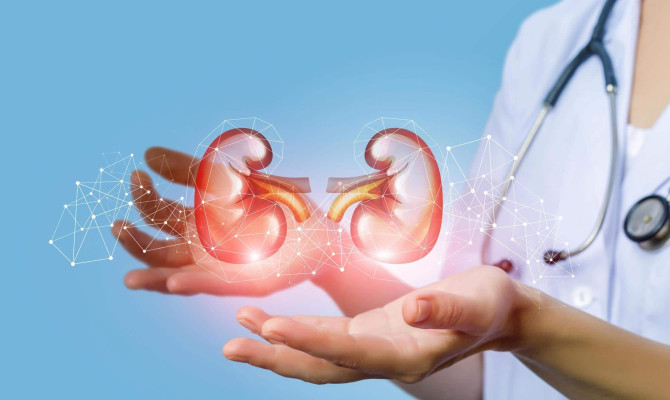Endometriosis : Know the types, causes, and treatment

- Endometriosis
- 17 Aug 2023
Overview
What is Endometriosis ?
When a woman is pregnant, the area of her body known as the uterus, also called the womb, is where the embryo develops into a baby. Endometrium refers to the tissue that borders the interior of the uterus.
Endometriosis is a disorder in which tissue that is comparable to the lining of the uterus grows in various areas in the body except for the uterus itself. These areas of tissue are referred to as “implants,” “lesions” or “nodules.” 1Overview| Researched based study from Medlineplus.gov

Types
Types of Endometriosis
Endometriosis creates a prolonged inflammatory reaction, which can lead to the production of scar tissue (adhesions, fibrosis) in the pelvis and other regions of the body. There have been several descriptions of different forms of lesions, including:3Types| Researched based study from Who.int
Cystic ovarian endometriosis
- Cystic ovarian endometriosis, also known as endometrioma, is a type of endometriosis that can be discovered in the ovaries.
Superficial endometriosis
- Superficial endometriosis is a form of endometriosis that mostly affects the pelvic peritoneum.
Deep endometriosis
- It can be seen in the recto-vaginal septum, the bladder, and the colon.
Endometriosis can even be discovered outside of the pelvis, however, this is an extremely uncommon occurrence.
Symptoms
Signs and symptoms of Endometriosis
Endometriosis is characterized by a variety of symptoms, the most prevalent of which are pain and an inability to conceive.
Additional common signs and symptoms of endometriosis include the following:
- Menstrual cramps can range from painful to downright incapacitating and, in some cases, develop progressively worse over time.
- The discomfort experienced either during or after sexual activity, often in the intestines or lower abdomen
- Experiencing cramping in the abdomen or back, or painful urine or bowel motions while you are having your period
- Heavy menstrual periods
- Spotting or bleeding that occurs prior to menstruation or in the interim between periods
- Problems getting pregnant 2Symptoms| Researched based study from Nichd.nih.gov
In addition, women who have endometriosis are more likely to experience:
- Painful bladder syndrome
- Digestive or gastrointestinal symptoms that are comparable to those of a bowel illness
- Exhaustion or a lack of energy
After menopause, some women experience a reduction in the severe discomfort that is typically associated with endometriosis. However, hormone therapy, like estrogen administration or birth control tablets, which are provided to alleviate the symptoms of menopause may cause the pain and other symptoms to linger.
Complications
Complications of Endometriosis
The primary complications related to endometriosis are:
- Infertility or subfertility
- Chronic pain 5Complications| Researched based study from Nlm.nih.gov
Endometriosis can also cause other persistent symptoms. These include:
- Dysmenorrhea
- Dyspareunia
- Dyschezia 5Complications| Researched based study from Nlm.nih.gov
Endometriosis can also cause a decrease in quality of life for patients, due to:
- Complications during surgical procedures
- Anatomical abnormalities caused by possible adhesions, bowel or/and bladder dysfunction
- Ovarian endometriomas could even lead to the development of cancer.5Complications| Researched based study from Nlm.nih.gov
Causes
Causes of Endometriosis
Endometriosis is a complicated disease that affects a significant number of women all over the world from the time they have their first period (menarche) until they reach menopause. This condition occurs irrespective of a woman’s ethnicity or social standing.3Causes| Researched based study from Who.int
It is believed that the development of this condition was influenced by a great deal of distinct variables. It is believed that endometriosis can be caused by the following:
Retrograde menstruation
- During retrograde menstruation, menstrual blood, which contains endometrial cells, travels back via the fallopian tubes and in the pelvic cavity when blood is flowing out of the body across the cervix and vagina during menstruation.
- It is possible for endometrial-like cells to be deposited outside of the uterus as a result of retrograde menstruation.
- These cells then have the potential to implant and thrive outside of the uterus.3Causes| Researched based study from Who.int
Cellular metaplasia
- Cells can undergo cellular metaplasia, which refers to the process by which they transform from one form to another.
- Cells that are located outside of the uterus undergo a transition into cells that resemble endometrial tissue and then begin to proliferate.
Stem cells
- Stem cells have the potential to be the origin of the disease, which can then spread throughout the body via the lymphatic and circulatory systems respectively.
Other factors
- There is a possibility that the development or survival of ectopic endometrial tissue is also influenced by other variables.
- Endometriosis, for instance, is found to be influenced by estrogen, which, in turn, amplifies the inflammation, growth, and discomfort related to the illness.
- However, the association between estrogen and endometriosis is a complicated one due to the fact that the lack of estrogen does not necessarily equate to the absence of endometriosis.3Causes| Researched based study from Who.int
Risk
Who is at risk of developing Endometriosis?
Anyone who has ever had menstrual periods is at risk for developing endometriosis. There are certain variables that can either increase or decrease the likelihood of you developing it.1Risk| Researched based study from Medlineplus.gov
- You have a close family person who suffers from endometriosis, such as your mother, sister, or daughter.
- When you were younger than 11 years old, you first experienced your menstruation.
- Menstrual periods are very quick (they last fewer than 27 days each).
- Your periods are heavy, and they persist for more than a week at a time.
You have a lower risk if any of the following apply to you:
- You have been pregnant previously
- Your first period probably didn’t start until you were well into your teenage years.
- You breastfeed your infants.
Diagnosis
How does a doctor diagnose if you have Endometriosis?
Talk to your primary care physician if you have any of the symptoms associated with endometriosis. In order to determine whether or not you have endometriosis, your physician will first ask you about your symptoms and then perform or prescribe one or more of the following diagnostic procedures:4Diagnosis| Researched based study from Womenshealth.gov
Pelvic exam
- Your physician will perform a pelvic check on you and feel behind your uterus to look for any significant cysts or scars.
- Endometriosis is more difficult to experience in regions where it is localized to smaller spaces.4Diagnosis| Researched based study from Womenshealth.gov
Imaging test
- If your doctor suspects that you have endometriosis-related ovarian cysts, he or she may perform an ultrasound examination 4Diagnosis| Researched based study from Womenshealth.gov
- Both diagnostic and non diagnostic forms of ultrasound make use of sound waves to produce images of the patient’s reproductive organs.
- Another frequent imaging test that can produce an image of the inside of your body is called magnetic resonance imaging or MRI.
Via medication
During an ultrasound, if your doctor does not detect any evidence of an ovarian cyst, he or she may prescribe the following medications:
- Hormonal birth control may help alleviate some of the discomfort that is associated with menstruation-related pelvic pain.
- Agonists of the hormone known as gonadotropin-releasing hormone (GnRH) suppress menstruation and reduce the amount of estrogen that is produced by the body. There is some evidence that agonists of the GnRH receptor can alleviate pelvic pain.
- If taking hormone therapy makes your discomfort go away, endometriosis is definitely the cause of your condition. However, the benefits of these medications will only last for as long as you continue to take them. It is possible that your discomfort will return once you have stopped using them.
Laparoscopy
- Laparoscopy is a form of procedure that allows your doctor to examine your pelvic region to look for endometriosis tissue. This can be very helpful in diagnosing and treating the condition.
Surgery
- Endometriosis can only be diagnosed with absolute certainty through surgical removal of the disease.
- There are instances in which medical professionals are able to diagnose endometriosis solely based on the presence of growths.
- Sometimes, in order to confirm this, they will need to extract a small tissue sample from the affected area and examine it under a microscope.4Diagnosis| Researched based study from Womenshealth.gov
Treatment
Treatment of Endometriosis
Treatments for endometriosis can be very different from one another, depending on the severity of the symptoms and whether or not pregnancy is wanted. There is currently no medication that will completely cure the condition.3Treatment| Researched based study from Who.int
There is a wide variety of drugs that can assist in the management of endometriosis and its associated symptoms.
- Painkillers & Anti-inflammatory drugs
- Hormonal medicines
- Birth control methods
- Surgery
Painkillers & Anti-inflammatory drugs
- Ibuprofen and naproxen are two examples of common non-steroidal anti-inflammatory medicines (NSAIDs) and analgesics (painkillers) that are utilized in the treatment of pain.
Hormonal medicines
- It is also possible for hormonal medications, such as GnRH-analogues, and contraceptive methods (commonly known as birth control) to assist with pain management and control.3Treatment| Researched based study from Who.int
Birth control methods
- Patches, pills, hormonal intrauterine devices (IUDs), vaginal rings, implants, and injections are all potential methods of birth control. People who are trying to conceive shouldn’t use these methods because it’s possible they won’t work.3Treatment| Researched based study from Who.int
Surgeries
- Those who struggle to conceive as a result of endometriosis may resort to a variety of medical and surgical fertility treatments in order to increase their chances of achieving their goal.
- Endometriosis lesions, adhesions, and scar tissues can occasionally be removed surgically. Surgery may also be used to remove scar tissue. Incisions can be kept to a minimum thanks to the advent of laparoscopic surgery, which involves inserting a little camera into the body in order to observe internal structures.3Treatment| Researched based study from Who.int
Talk to a medical professional about the different treatment choices that are available to you.
Prevention
What steps can I take to protect myself from developing Endometriosis?
One cannot prevent endometriosis. However, by reducing the amount of the hormone estrogen that is produced in your body, you can lessen the likelihood that you will acquire the condition. During the course of your menstrual cycle, estrogen has a role in helping the lining of your uterus to become more dense. 4Prevention| Researched based study from Womenshealth.gov
Keeping estrogen levels in your body at a lower level can be accomplished by the following:
- Have a discussion with your healthcare provider about the possibility of using hormonal birth control options, such as birth control pills, patches, or rings that contain lower levels of estrogen.
- Perform physical exercise on a consistent basis (for more than four hours per week). This will assist you in maintaining a low percentage of body fat. The quantity of estrogen that is circulating through the body can be decreased by engaging in regular physical activity and maintaining a healthy body fat percentage.4Prevention| Researched based study from Womenshealth.gov
- Drinking excessive amounts of alcohol is not recommended. Alcohol boosts estrogen levels. Women who wish to drink alcohol should limit themselves to no more than one drink per day, as this is the maximum amount that is considered safe.
- Steer clear of drinking excessive amounts of beverages that contain caffeine. According to a number of studies, increasing the amount of caffeinated beverages you consume on a daily basis, particularly carbonated beverages and green tea, can lead to an increase in estrogen levels.
Takeaway
Takeaway tips
- Endometriosis is a condition in which tissue that is analogous to the lining of the uterus grows in areas of the body other than the uterus. It can cause excruciating discomfort in the pelvic region and make it more difficult to conceive a child.
- Treatment options are determined by factors such as the patient’s preferences, the effectiveness of the treatment, any potential adverse effects, the level of long-term safety, as well as cost and accessibility.
- Increasing awareness can assist in the early diagnosis of some conditions in individuals. The natural progression of the disease can be slowed or stopped entirely by receiving treatment early on, which can also lower the severity of the symptoms that are experienced over time.
- People who attend local patient support groups may discover that they are able to obtain additional counsel and emotional assistance in addition to what they receive from their doctor.
Any feedback on this article?
 This Articles content was accurate
This Articles content was accurate Very Informative Article
Very Informative Article I have a question or a comment
I have a question or a comment
 This article contains inaccurate content
This article contains inaccurate content This article was not helpful
This article was not helpful I have a question or a comment
I have a question or a comment
We appreciate your helpful feedback!
Checkout our social pages
References
-
Medline Plus
Endometriosis | Overview | Risk
-
Eunice Kennedy Shriver National Institute of Child Health and Human Developmen
About Endometriosis | Symptoms
-
World Health Organization
Endometriosis | Types | Causes | Treatment
-
Office on Women's Health
Endometriosis | Prevention | Diagnosis | Treatment
-
National Library of Medicine
Endometriosis | Complications





































